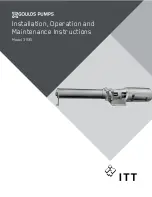
4 Installation
4.1 Location
Pumping unit should be placed as close as practical to the source of supply. Floor space and head room
allotted to the unit must be sufficient for inspection and maintenance. Be sure to allow for crane or hoist
service.
4.2 Installation
Model 3935 pumps are multi-stage pumps, closecoupled to the driving motor. The pump should be sup-
ported only at the bearing frame (at the motor on pumps with Y frame) and pump foot. The unit should be
bolted to a substantial, rigid base to prevent distortion of the pump.
Pumps should not be hoisted in the air for mounting purposes with the motor bolted to the frame. Motors
should be mounted after the pump is securely installed on its permanent base.
On high temperature service, a gap should be left between the pump foot and end of the casing, or
shoulder of the discharge head, to allow for thermal expansion. The pump foot bolt (371U) should not be
tightened down until pump has reached operating temperature.
The discharge head should never be loosened or tightened to make up piping downstream of the pump.
On pumps with flanged suction and discharge connections, the pump foot fits over the casing.
Oil lubricated pumps must be installed in the horizontal position. Grease lubricated pumps may be instal-
led in the vertical position, but should have the motor above the pump. The Model 3935 should never run
dry. If there is any possibility that the pump's source of liquid might fail, a protective device should be
incorporated into the system to shut the pump down.
4.3 Piping
The pump should not run with a closed discharge for more than a few minutes, such as during startup or
shut-down. Sufficient heat can be transmitted to the fluid causing the liquid to vaporize and allow the
pump to run dry and fail. The suction pipe should never be of smaller diameter than the pump suction.
Use of suction pipe one or two sizes larger than the pump suction, with a reducer at the pump suction, is
desirable. The pump should never be throttled on the suction side. Quick closing valves should be avoid-
ed in the discharge line to protect the pump from damage due to surging and water hammer.
For operation at low flow, or to insure liquid will always be flowing through the pump, a bypass line
should be installed. The bypass line should be returned to the liquid source and injected below minimum
liquid level to prevent air entrainment.
If a bypass line is not used, it is recommended that precautions be taken to ensure that the pump will not
run dry, run at closed discharge, or handle pumpage of excessive temperature at pump suction. Devices
which can protect the pump from the above problems are flow switches or high temperature switches.
When handling liquids at elevated temperature, it is suggested that expansion loops or joints be installed
in the suction and discharge so that expansion of the piping will not impose excessive strain on the
pump.
Additional information on piping can be found in
Hydraulic Institute Standards
.
4 Installation
12
Model 3935 Installation, Operation and Maintenance Instructions















































